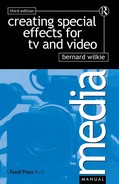Frost and Ice
Frost
If properties or scenery are lightly wetted they can be given a coating of talc or powdered chalk blown from the palm of the hand. If a stronger bond is required, a small quantity of soluble glue can be added to the water. Aerosol sprays of ‘Christmas’ frost can be acquired from specialist suppliers and party shops.
For misted windows that need to be cleared in vision it is possible to spray a clear spirit mixed with talcum powder. NOTE: With most volatile spirits, there is a fire risk during spraying.
Ice
For a small area of ice on the surfaceof water (tubs, sinks, small ponds, etc.) paraffin wax may be used. The wax is melted and poured onto the surface of the water which itself must be hot. When both have cooled, the wax sets in a smooth layer similar to natural ice. It will break realistically.
For larger areas, the wax can be prepared separately in shallow trays (the smaller the depth of water the quicker the process) and floated on water where required. A square vessel is preferable to a round one because ice breaks in semi-straight lines. Thickness depends on the amount of wax used.
Very large areas (rivers and lakes) can be covered with thinly cut expanded polystyrene sheets, the upper surfaces of which may benefit from being painted (natural ice is more often grey than white).
Ice blocks
To create a block of ice it is possible to construct a credible simulation from sheets of acrylic resin (Plexiglas or Perspex) which have been heated and distorted. Welded together to form a tank and filled with water these sheets will look realistic, although size is limited. Fill through a single hole. Laid flat (a human body discovered under the ice perhaps?) the internal water pressure presents few problems. Stood upright however, the head of water may burst the lower seams. Action with this sort of prop is limited and should be avoided where weight is a factor.
There are few reasons why real ice blocks should not be used if a quick shoot can be guaranteed. Stored in a container along with dry ice their temperature can be reduced, delaying a melt down. Ice thus super-cooled should not be handled with naked hands.
SNOW, FROST AND ICE
Ice and snow effects must usually be applied in such a way that they do not permanently damage scenery or props.
1. Snow dropping box
This motorised unit has a spiked revolving rod which distributes shredded paper through the slots in the trough.
2. Frozen prop
a, Applied frost, b, Resin icicles, c, Cloth covered in sawdust, d, Sandbags to build up drifts, e, Wax ice. f, Heaped polystyrene granules.

